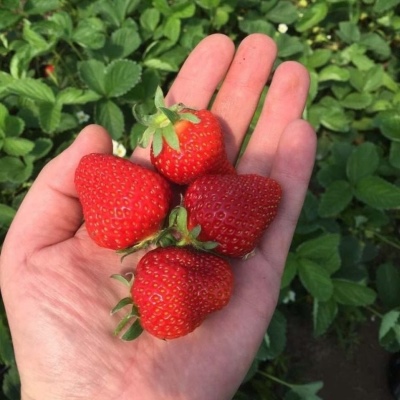
- Authors: breeders of Crimea
- Taste: sweet
- The size: large
- Weight: 20-25 gr
- Yield rate: very high
- Yield: up to 1.5 kg per bush
- Repairability: Yes
- Ripening terms: early
- Appointment: processing (juice, jam, jam, etc.)
- Berry color: Dark red
Crimean strawberry is an unpretentious variety that can grow in Siberia and bear fruit several times per season. The plant is remontant, which makes strawberry bushes in demand among gardeners.
Description of the variety
The variety was brought out by breeders from the Crimea. The peculiarity of the plant is that it easily tolerates even the most severe frosts and is able to grow in the northern regions of the country. Main characteristics:
- average height of the bushes;
- sprawling dense leaves of rich green color;
- low peduncles.
Whiskers in the process of growing strawberries give a little, which makes it easier to care for the bush.
Ripening terms
Seeds of remontant strawberries sprout 5 days after planting. Strawberries bear their first fruits in May. Fruiting twice a season on average.
Yield
The yield is high, reaching 1.5 kg of berries per bush.
Berries and their taste
The fruits of the plant are colored bright red and have a rounded shape. Crimean strawberries are suitable for both ready-to-eat and homemade preparations. The berries are delicious:
- jam;
- compotes;
- jam.
The fruits of the variety are distinguished by a pleasant strawberry aroma and sweet taste.
Growing features
Strawberries tolerate excess or lack of moisture. Therefore, it is not recommended to water the plant frequently. This is explained by the fact that with strong watering, the bush will leave some of the moisture in the ground as reserves. The frequency of watering should be 1 time per 2 weeks.
Another feature is the small number of mustaches. Therefore, the distance between rows and seedlings can be reduced, which allows you to increase the amount of yield by planting more bushes.




Site selection and soil preparation
The variety is recommended to grow in elevated places exposed to the sun's rays.As for the type of soil, it does not matter here. Crimean strawberries take root well in almost any land. However, the ideal option would be a soil with low acidity.
Before planting seedlings:
- remove weeds;
- digging up the site;
- fertilize the ground.
Planting is carried out in rows. A distance of 20-30 cm should be maintained between adjacent strawberry bushes. This will be quite enough for the development of the bush.
During planting, holes are made in pre-marked places, where seedlings are lowered. Then the remaining space is filled with earth, the soil is tamped and watered abundantly.

Pollination
Carried out by insects. If strawberries are grown at home, then you should take care of artificial pollination of flowers. Otherwise, the variety will not produce berries.
Top dressing
Crimean strawberries love fertilizers, and for the active growth of the bush, regular application of nutrients to the soil is required. To do this, you can use complex fertilizers that are sold in garden stores.
If you plan to fertilize with organic matter, then preference should be given:
- chicken droppings;
- urea solution;
- humus.
Wood ash can be used as a mineral fertilizer.

One of the important techniques in strawberry care is feeding. Regular fertilization guarantees a rich harvest. There are several different ways to feed strawberries, and each of them is designed for a specific period of plant development. During flowering, fruiting and after it, feeding should be different.

Diseases and pests
The variety has a strong immunity to all types of diseases and pests. However, this does not cancel prophylaxis in the form of planting in the aisles:
- marigolds;
- marigold.
Onions or garlic planted next to strawberries will help scare off unwanted insects.

Strawberries are often subject to many dangerous diseases that can seriously undermine their condition. Among the most common are powdery mildew, gray mold, brown spot, anthracnose, and verticillosis. Before buying a variety, you need to inquire about its disease resistance.
Reproduction
Gardeners practice strawberry propagation by sowing seeds or by dividing a bush. The first option is the most popular. Planting of seeds begins in February or March, depending on the climatic characteristics of the region.
Seeds are planted in a prepared soil mixture, the composition of which includes:
- 50% soil from the garden;
- 30% peat;
- 20% river sand.
As a result, a loose soil is obtained, which passes water well and provides the seeds with the required amount of moisture. The earth is placed in a carefully washed plastic container. Before you start planting seeds, the soil is watered with warm water. Only after that, the seeds are carefully transferred to the soil surface and the container is covered with foil.
Crimean strawberry is a popular variety that is prized by gardeners for its frost resistance and high yield. The bushes are unpretentious to care for and quickly take root in any soil.



















































































